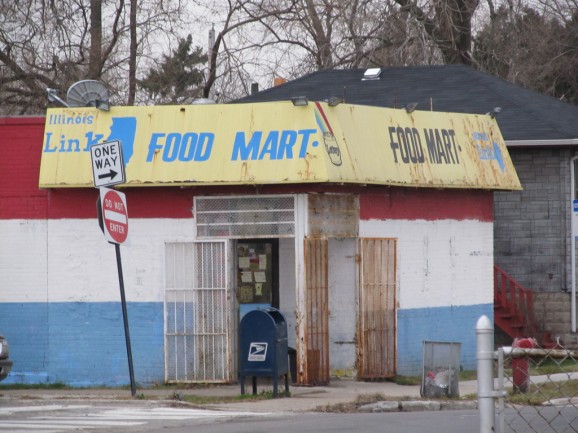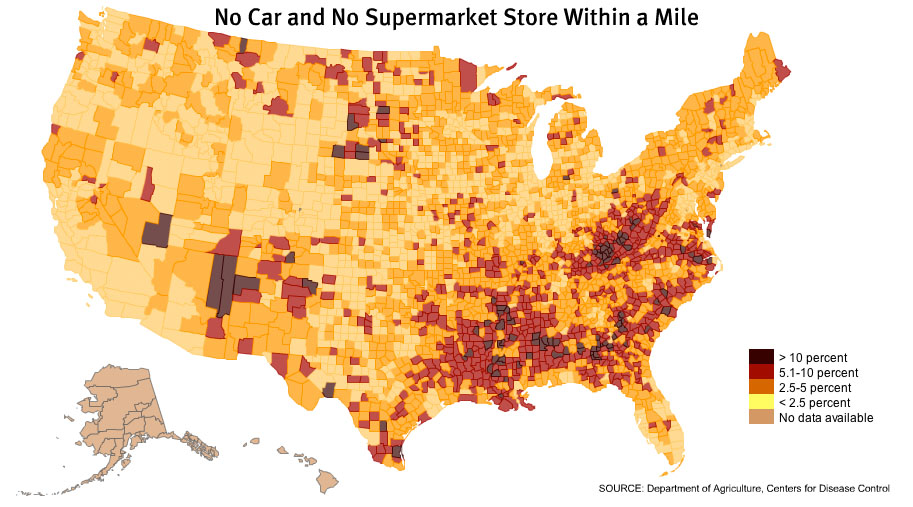food deserts defined and examined
What exactly is a food desert?
The term food desert was first coined in the 1990s in Scotland. It is used to describe locations where there is little or no access to healthy foods. This is often due to a lack of “normal” and “safe” food sources (i.e. supermarkets). When residents do not have regular access to healthy foods, they become classified as food insecure.
The term food desert has come to be the embodiment of urban decay. In America, approximately 10% of the population lives in a food desert. For an area to be considered a food desert, at least 20% of inhabitants must be below the poverty line and 33% of the population must live more than a mile from a supermarket in urban areas or 10 miles in rural locations. In food deserts, individuals must expend greater resources to reach normal food sources and these are the areas that often have the fewest resources to use. The most significant limitations include financial restraints, physical ailments and a lack of transportation.
Who is affected by food deserts?
The negative effects of food deserts disproportionately affect locations primarily populated by the elderly and the poor with age, income and educational levels being the factors that are most strongly related to food insecurity levels. It is theorized that this has been caused by the consolidation of food retailers which has driven smaller retailers from these locations at a greater rate.This trend can be seen in both urban and rural locations.
Why are some areas more dramatically affected?
This is a difficult question to answer, but it can likely be attributed to the cycle of poverty that restricts the quality of life in many poor areas. However, there are other factors that need to be more thoroughly examined and the question, “Is the issue of food deserts a problem of supply or demand?” needs to be addressed.
There may be in fact little or no demand for healthier options which stems from varying sociocultural views on food, rather than food access. Additionally, simply providing healthy food options does not change consumer behavior. Some people just do not care about their dietary health. These factors are typically influenced by age and gender.

Furthermore, it may not be that there is a lack of access, but the lack of necessary funds needed to purchase healthy foods (it is estimated that fruits and vegetables cost up to 36% more than the national average in food deserts). There is also the issue of not having the necessary skills or knowledge to prepare many fruits and vegetables after several generations of dependency on fast and convenience foods.
Are there other food sources that can help alleviate problems caused by food deserts?
There are three major categories of food sources:
- Normal sources: retailers
- Government food assistance: WIC, school lunch programs, nutrition assistance for the elderly
- Alternative food sources: gifts, private charity
What are some possible solutions for addressing the issue of food deserts?
In the past, many of the solutions have been solely focused on the number of calories that receivers of assistance consume, rather than the quality of food they are consuming. In order for solutions to be long-term and “worth” the investment this perspective must change.
Among the variety of options, the most viable solution that will be the most broadly beneficial is strengthening the social infrastructure of a given area. This is accomplished by encouraging social connections between families, friends and neighbors as studies have shown that increases in social capital decrease the likelihood that members of the community will have hunger issues.
The most common methods for developing social infrastructures are traditional options which include opening low-cost/free food pantries (often associated with religious institutions), visiting farmers markets and offering senior meal programs.
Other options include:
- Building up support for local retailers: shopping at Wal-Mart may seem like it is cheaper, but the real cost of dependency on businesses with little empathy for the community is more often than not detrimental in the long-run.
- Developing transportation networks: beneficial not only to those using the service but to the environmental, too.
- Encouraging the retail sale of locally produced food: the revenue stays in the community where it is really needed
- Establishing gardens to plant enough food to share: produces local (and often organic) food and provides an opportunity for social interaction.
- Expanding civic organizations (ex. VFW, churches, rotary club): these types of organizations were once pillars of communities and provided opportunities for social networking.
- Investing in living wage industries: should anyone really be working full-time and not have the ability to buy food?
- Volunteering time at local farms in exchange for access to meat or other goods produced: the average age of farmers is increasing while interest in farming wanes. Renewing the connection between communities and their food sources may help to reduce the centralization of the food system and redistribute consumer power.
Those solutions sound great, but what type of problems might be encountered when applying them to real-life situations?
The very definition of food deserts can cause problems when working towards long-term, positive solutions. This is due to the fact that the USDA excludes farmers markets, small farms, smaller retailers and road stands from its definition of a food desert. This means that solutions are being developed without access to all of the pertinent information which can spur resentment from the existing infrastructure. Such an issue is particularly pertinent when attempting to develop decentralized and locally beneficial options (why couldn’t small corner store serve as viable replacements for traditional grocery stores?).
Then the fact that only about 15% of people shop for food in their census area. It is hard to estimate whether consumers will change their habits if new infrastructure is developed. The type of infrastructure also plays a role as many individuals in food deserts resent alternative food systems as they represent the idea that where they live is not good enough for a conventional supermarket. This issue is often amplified by the romanticized “if they only knew” logic which does not typically reflect the values of those being affected. Often organic, farm-fresh or vegetarian is considered less than palatable and even dirty or disgusting.
When discussing social factors that could hinder efforts, the racial and cultural relationship between various groups throughout the country need to be considered. For example, in areas primarily populated by minorities (in this case Blacks), there is the notion that the efforts being made are an attempt to inject white food values into the community and are the embodiment of white privilege (alternative food options tend to be perpetuated by Whites). Issues of former land stewardship make the idea of growing their own food unpleasant and does not appeal to this demographic. This group also seems to prefer the anonymity of grocery stores and resents the eugenic nature of “knowing where your food comes from”. Furthermore, the mere definition of a food desert can also be considered disrespectful as it invokes images of a location beyond repair (see: Bringing Good Food to Others).
Finally, there is the issue of governmental priorities. Should people be fed or should tax breaks be given? Is a new truck for the sheriff or a community garden more important? Voter apathy allows a very small percentage of residents to make that decision.
If there are so many problems and people resent the type of help offered, why bother caring?
The simplest answer is because we are all humans in a time of great uncertainty and inequality. If thoughtful measures are not made now, problems with food access will only continue to grow. As the insecurity grows, it will affect more and more people. It will also balloon into problems in other areas of life (ex. riots in the Middle East).
Moreover, there are economic incentives. It is estimated that a $1 of investment in grocery stores equals $1.50 in returns which means that such an investment has the potential to benefit several different groups simultaneously. As an added bonus, it creates a way to bridge private and public interests.
sources:
Barker, ME., Campell, MJ., Pearson, T., Russel J., Oct 2005. Do food deserts influence fruit and vegetable consumption? — a cross-sectional study. Appetite. 45(2) 195-197.
Gordon, S. 2011. Urbanites cry foul on USDA definition of food deserts. Earth Eats.
Guthman, J. 2008. Bringing good food to others: investigating the subjects of alternative food practice. Cultural Geographies, 4, 431-447.
If you build it, they may not come. 2011. Economist. http://www.economist.com/node/18929190
Wright, M. L., Bitto, E. A., Oakland, M. J., Sand, M. 2005. Solving the problems of Iowa food deserts: food Insecurity and civic structure. Rural Sociology, 70, 94-112.




3 Comments
Comments are closed.